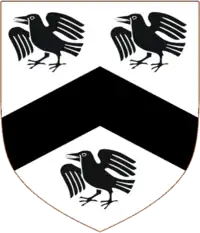George Rice-Trevor, 4th Baron Dynevor
George Rice-Trevor, 4th Baron Dynevor (5 August 1795 – 7 October 1869)[1] was a British politician and peer.
George Rice-Trevor, 4th Baron Dynevor | |
|---|---|
_-_Colonel_George_Rice-Trevor_(1795%E2%80%931869)%252C_4th_Baron_Dynevor_-_869205_-_National_Trust.jpg.webp) Portrait by John Lucas | |
| Member of the United Kingdom Parliament for Carmarthenshire | |
| In office 1820–1831 | |
| Preceded by | Lord Robert Seymour |
| Succeeded by | Sir James Hamlyn-Williams, Bt. |
| Member of the United Kingdom Parliament for Carmarthenshire | |
| In office 1832–1852 Serving with
| |
| Preceded by | Sir James Hamlyn-Williams, Bt. |
| Succeeded by |
|
| Personal details | |
| Born | 5 August 1795 |
| Died | 7 October 1869 (aged 74) Malvern, Worcestershire, England |
| Resting place | Barrington Park, Gloucestershire, England |
| Political party | Conservative |
| Father | George Talbot Rice, 3rd Baron Dynevor |
Early life
He was the son of George Talbot Rice, 3rd Baron Dynevor. Dynevor matriculated at Christ Church, Oxford 13 October 1812; he was awarded a D.C.L. on 11 June 1834. By royal licence, 28 October 1824, he took the name of Trevor, after that of Rice, on inheriting the estates of the Trevor family at Glynde, Sussex.
Political career
He served as Tory Member of Parliament (MP) for Carmarthenshire, from 1820 to 1831. At the 1831 General Election he chose to stand down from the Commons on the basis that his political views diverged from those of his constituents.[1] The following years, however, he contested the seat and was re-elected, serving until his elevation to the peerage in 1852 upon the death of his father.
Rebecca Riots
When the Rebecca Riots of 1843–44 reached Carmarthenshire Rice-Trevor, as a militia officer, and MP and vice-lieutenant of the county, returned from London to deal with the situation. After the rioters burned crops on his father's Dinefwr estate he threatened armed retaliation. The response of the rioters was to dig a grave in the grounds and announce that Rice-Trevor would occupy it by 10 October 1843. He did not, but he did order in so many troops and police that a barracks had to be built to accommodate them.[2]
Later life
Lord Dynevor succeeded to the title of Baron Dynevor and the Dinefwr estate on the death of his father in 1852. He was an honorary colonel in the militia and from 1852 to 1869 he served as ADC to Queen Victoria.
Personal life
On 27 November 1824 he married Frances Fitzroy, daughter of General Lord Charles Fitzroy (a younger son of Augustus FitzRoy, 3rd Duke of Grafton). The couple had the following children:
- The Hon. Frances Emily Rice (1827– 26 November 1863)
- The Hon. Caroline Elizabeth Anne Rice-Trevor (1829 – 12 August 1887), married Thomas Bateson, 1st Baron Deramore
- The Hon. Selina Rice-Trevor (11 September 1836 – 22 January 1918)
- The Hon. Elianore Mary Rice-Trevor (born 1839)
Dynevor died on 7 October 1869, aged 74, at Malvern, Worcestershire from paralysis and was interred in the family vault at Barrington Park, Gloucestershire. As he died without male issue, his cousin the Reverend Francis William Rice succeeded to the barony. The family wealth passed to his daughters, thus splitting the wealth from the title.
  |
|
References
- "The Death of Lord Dynevor (editorial)". Welshman. 15 October 1869. p. 5. Retrieved 12 April 2015.
- "Trevor Rice (1759-1869)". Retrieved 29 January 2018.
- Debrett's Peerage. 1973.
External links
- Hansard 1803–2005: contributions in Parliament by George Rice-Trevor
| Parliament of the United Kingdom | ||
|---|---|---|
| Preceded by Lord Robert Seymour |
Member of Parliament for Carmarthenshire 1820–1831 |
Succeeded by Sir James Hamlyn-Williams, Bt. |
| Preceded by Sir James Hamlyn-Williams, Bt. |
Member of Parliament for Carmarthenshire 1832 – 1852 With: Edward Hamlyn Adams to 1835 Sir James Hamlyn-Williams, Bt. 1835–1837 John Jones 1837–1842 David Davies from 1842 |
Succeeded by David Jones David Davies |
| Peerage of Great Britain | ||
| Preceded by George Talbot Rice |
Baron Dynevor 1852–1869 |
Succeeded by Francis William Rice |